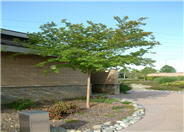
Common name:Crape Myrtle
Botanical name:Lagerstroemia indica
The new leaves of this species are 2" long, bright green, and tinged with bronze. Some cultivars have spectacular fall color. When it has a bare outline, its rounded seed capsules add interest. Its delicate flowers bloom in 6"-12" long clusters. The flower colors could be shades of red, rose, pink, purple, and white, blooming in summer. It thrives on heat, and new cultivars have been created that resist mildew. This tree prefers full sun and has low watering needs once it's established.
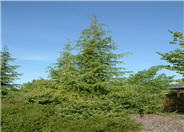
Common name:Deodar Cedar
Botanical name:Cedrus deodara
This fast-growing, coniferous evergreen is capable of reaching a size of 80' high by 40' wide. Its needles are a light, silvery green color, 2" long. Flowers are inconspicuous. Barrel shaped cones appear in fall and winter. Branches are pendulous and spreadings. Plant in area that has ample room for growth.
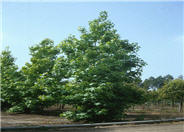
Common name:Liquidambar, American Sweet Gum
Botanical name:Liquidambar styraciflua
A tall, deciduous tree of upright, pyramidal habit, the liquidamber has dark green, maple-like leaves that turn beautiful shades of red and yellow in the fall season. It can be used as a single specimen, hedge, or grouped plant.
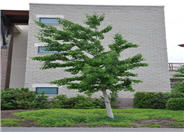
Common name:Maidenhair Tree, Ginkgo Tree
Botanical name:Ginkgo biloba
The Ginkgo biloba, with its distinct fan-shaped leaves, initially grows with a pyramidal habit, but later becomes wide-spreading. It is generally not bothered by insects or disease. It slowly reaches 35'-50' tall and wide. It needs regular watering and more during hot summer months. Flowers are inconspicuous. Fall color is spectacular with changing color of leaves from light green with a yellow tinge to yellow.
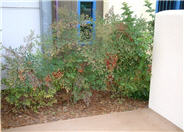
Common name:Nandina, Heavenly Bamboo
Botanical name:Nandina domestica
Nandina domestica is a graceful upright shrub that grows from 3'-6' in height. It gets its name from its bamboo-like growth habit. When thinned from the center it bears a remarkable resemblance to bamboo. It is best used in groups. It can be used in a shaded patio or out in a shrub border with full sun. An interesting feature of Heavenly Bamboo is the bronze color in the new growth when planted in full sun. It also bears clusters of white flowers in the spring.

Common name:Rojo Alto Daylily
Botanical name:Hemerocallis 'Rojo Alto'
This statuesque screaming fire engine red with a yellow throat is a show stopper.This beautiful perennial reaches about 3' tall with green grass-like foliage. Flowers, which resemble lilies, bloom in spring and summer. Cut foliage in fall to refresh plant. It prefers full sun but will take dappled shade, with lots of compost. Mulch plant well to help retain water. Hemerocallis needs a medium amount of watering to have prolific blooms.
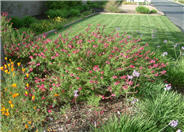
Common name:Rose Pink Texas or Autumn Sage
Botanical name:Salvia greggii 'Rose Pink'
This shrub will grow 1'-4' tall and 1'-4' wide. It has glossy green leaves with pink flowers that bloom from fall to spring.
More than half of the water used at your home is for outside purposes. Studies show that on average, half of the water used outdoors is wasted. The leading cause of waste is incorrectly set and poorly managed irrigation controllers. The second biggest cause of wastage is broken irrigation equipment that goes undetected. There are a few basic things you can do to make a big difference in your water use.
Click in the green box for more information
Designer: Susan Stiltz
Photographer: GardenSoft
Physical weed control, including mulching, or hand removal protects the watershed from harmful chemicals.
Remove irrigation water and fertilizer from areas where you don't want weeds to grow.